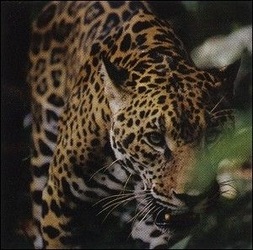 TRENT'S WALK IN THE BELIZEAN JUNGLE (Part Seven) Is brought to you by "Grand Belizean Estates" the next place to call home.  JAGUAR SIGHTING This animal gives me goose-bumps! Now I didn't exactly come across one of these on my "Walk Through the Jungle", but how can I not write about this amazing animal? This Central American "Big Cat", is the third largest cat in the world. The jaguar is so special to the Belize people, that the government has taken over 155 square miles of land and set it aside as a jaguar sanctuary, to preserve the "Big Cat" of Belize. They can weigh as much as 300 lbs, some weigh less, but they are awesome nonetheless. A jaguar has massive shoulders, and huge forepaws, with claws to grasp anything they set their little (or should I say....large) heart upon. Their jaws can crush any skull, so these "Big Cats" deserve your respect. The truth is, jaguars are non-aggressive towards humans unless provoked, or until they have been attacked by man in a more outright manner. Some jaguars have been found raiding livestock, but also remember, what man has done in the past few years by depleting the jaguar's natural habitat for food, with deforestation. This is when our government stepped in and said, "No More!" and the Cockscomb Jaguar Sanctuary National Park was established in 1986. The jaguar spends much of the day snoozing on a bed of leaves, or sunning itself on a log or ledge. It may get around to making an occasional ground scrape or the odd tree scratch to serve as boundary markets, delineating its territory. Although ranges may partially overlap, they generally are not shared. To the male jaguar, his hundred or so kilometers of jungle - is his kingdom, whereas the female may choose to change her castle - and with it, her mate. Females begin breeding at about three years. Gestation is approximately three months. A female jaguar will normally have about two cubs to a litter. If they manage to survive, the mother will remain caring for her cubs going into the following year. Jaguars become active at night, stalking the peccary by preference but, if none are available, they will settle for agoutis, monkeys, deer, birds, even lizards and fish. The kill is accomplished by a bite at the neck. The jaguar is still hunted - illegally - for its beautiful yellow-brown or buff colored coat, which looks like an artist painted on it, elegant black spots, rosettes and butterflies. The greatest danger to the jaguar, however, is human encroachment on its home territory. As the forests of its range (northern Mexico to Argentina) recede, its life is in jeopardy, even when prey is still available, jaguars do not appear to be highly adaptable to enforced change. Hopefully, here in Belize there is a future for the jaguar, with the establishment of the world's first Jaguar Preserve in the Cockscomb Forest Reserve. A public awareness of the jaguar's plight will assure not only that its inherent rights will be respected but that the glory of its existence will be appreciated for many years to come.
1 Comment
|
Trenton Turley
Hi, my name is Trenton S. Turley. I've been living in Belize now for 11 years. Hope you enjoy reading my many blog posts. I write about things, that are passionate to me.
SNAKES OF BELIZE!
Check out, my my current blog series on Snakes of Belize. Categories
All
Archives
April 2016
|





 RSS Feed
RSS Feed